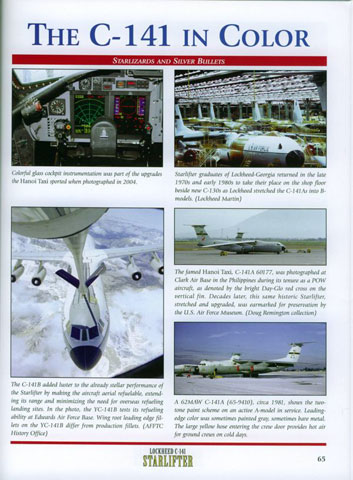S u m m a r y
|
| Title: |
Warbird Tech Series
Volume 39 Lockheed C-141 Starlifter |
| ISBN: |
1580070809 |
| Media and Contents: |
Soft cover,
104 pages |
| Price: |
USD$16.95 from the Specialty Press Website |
| Review Type: |
First Read |
| Advantages: |
Detailed history
of the type from inception to its sunset years. |
| Disadvantages: |
|
| Recommendation: |
Recommended |
Reviewed by Ken Bowes

Warbird Tech's
Lockheed C-141 Starlifter will be available online from Squadron
In the late 1950s it was
realised that the global commitments of the United States military, with
the consequent requirement for rapidly deploying forces, were
outstripping the capability of the Military Air Transport Service (MATS)
of the USAF. MATS Commander, GEN Tunner, set out a set of visionary
requirements for a new USAF airlifter which after much political and
military to-ing and fro-ing resulted in the C-141. This aircraft was to
build on the success of the C-130 with the range and speed of a jet
aircraft and achieved this aim from day one.
 Perhaps
the greatest improvement made was to ensure that the undercarriage did
not intrude into the payload area. As anyone who has travelled for six
hours with their knees locked between those of the passenger opposite in
the wheel-well area of the C-130 can attest, this must have been a
fantastic improvement for troops. That said the true improvement was to
adopt a high-wing layout, allowing loading and unloading from normal
truckbed heights and unobstructed roll on and off of vehicles under the
t-tail. This configuration set the standard for all military air-lifters
on both sides of the iron curtain. Perhaps
the greatest improvement made was to ensure that the undercarriage did
not intrude into the payload area. As anyone who has travelled for six
hours with their knees locked between those of the passenger opposite in
the wheel-well area of the C-130 can attest, this must have been a
fantastic improvement for troops. That said the true improvement was to
adopt a high-wing layout, allowing loading and unloading from normal
truckbed heights and unobstructed roll on and off of vehicles under the
t-tail. This configuration set the standard for all military air-lifters
on both sides of the iron curtain.
The C-141 in all its guises is
well covered in this book. Not just the C-141A, B and C transport models
but also the variety of special mission aircraft such as the NC-141A
that towed an F-106 aloft in NASA’s Project Eclipse in 1997/98. A glance
through the contents highlights that there will be something to be found
for everyone in this volume from origins to technical description,
colours and markings to flying the aircraft. Of particular interest is
the chapter entitled “What Might Have Been” which details such design
proposals as an air defence missile launcher (in essence and airborne
SAM system), conventional bomber carrying 54 000lbs of bombs, air to air
refuelling tanker to replace the KC-130 and AEW&C platform amongst
others. The eight pages of colour also provide some tantalising
modelling subjects including desert camouflage trials and the ghost gray
trials scheme of the late 1970’s reminiscent of the current day USMC
KC-130.
Concluding the book are three useful appendices. These are where the
reader will find the facts and figures including full serial list for
all Starlifters produced, a run down on the location and status of all
preserved airframes and finally two pages with a chronology of key dates
in the history of the Starlifter from the call for bids in 1960 to
design a new generation transport until Mid-2004 as some of the 24
remaining USAF Starlifters continued missions in support of Operation
Iraqi Freedom. This is an excellent and enviable record for any
operational type.
This Warbird Tech Volume is a very detailed look at the history and
employment of the type, with numerous colour and black and white
photographs coupled with drawings useful to the modeller. It will prove
a very useful volume for anyone who wishes to build a replica of the
C-141, although unfortunately unless the tigers of the Far East come to
our rescue some time soon, the various kits available have shortcomings
in terms of age, scale or accuracy.
The book will serve both history buffs and modellers well.
Recommended.
Thanks to Karin of
Specialty Press for the review sample
Review Copyright © 2005 by
Ken Bowes
This Page Created on 04 August, 2005
Last updated 04 August, 2005
Back to HyperScale Main Page
Back to Reviews Page
|
Home | What's
New | Features
| Gallery |
Reviews | Reference
| Forum
| Search